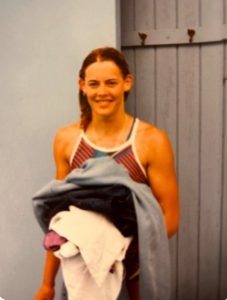Waking up at six a.m. on an early Wednesday summer morning, Estella Frakes, a Woodgrove junior, gets up and prepares to go to morning practice, mentally preparing to swim from 6:30 to 7:30 for the Franklin Park Stingrays. Estella has been swimming on the Franklin Park swim team since she was eight years old and now also swims for Woodgrove’s very own swim team.

When it comes to swimming competitively, there are different opportunities to be on a swim team. Locally, there are summer swim teams, year-round swim teams, or high school swim teams. After high school, there are college teams, club teams and, of course, the Olympics. There are different factors for each of the different teams, including different time stamps for practices and meets and distances.
Summer swim team is the most unique. As it is only in the summer, the swim meets are longer. In summer swimming, the longest distance you swim is the 100 yard Individual Relay, otherwise known as IM for swimmers, which is 25 yards of each individual stroke. These strokes are butterfly, backstroke, breaststroke, and freestyle. Year-round swim teams are teams that swim all year. They use indoor pools and swim shorter distances during the colder months and use outdoor pools and swim long-course distances during the warmer months. Shorter distances are in a pool that is 25 yards long, while a longer distance is 50 yards. High school swim teams tend to have only one season. In Loudoun County Public Schools, that season is winter. The practice times are at night whereas summer swim and some year round swim practices are early in the morning.
In competitive swimming, you can start at any age. Some may start before they turn ten, others may start in teenage years or even at an elderly age. Katrina Honcharik, former Woodgrove student and swimmer, who is now at Christopher Newport University majoring in Biology and minoring in Chemistry, said, “I’ve been swimming since I was seven years old. As a little kid, my parents put me through different sports, and swimming was the only one I liked and I enjoyed a lot. Then I started with my summer swim team, the Lovettsville Dolphins, and then I joined a year-round team when I was eight.” Tami Carlow, who is a teacher assistant in special education as well as former head coach of Woodgrove’s swim team, shared, “When I was 12 years old, I started with summer swimming. My parents said that I had big shoulders and that I should become a swimmer.” Honcharik and Carlow both prove that no matter how old you start with swimming, you can still become a dedicated swimmer.
At swim competition meets, it is important to make sure to be mentally and physically prepared. Frakes shared, “I like to visualize the race, my flip turn, and finish.” Painting an image in the mind helps one prepare and know what to do. Honcharik explained, “I know one coach where we would do a meditation where you would envision your event. That was kind of helpful, but also just mentally prepare, get a good night’s sleep, and make sure to eat a little something beforehand.” It is good to eat before racing as it gives energy and protein in the body which when racing, the energy gets burned off.
Sports can have many advantages, especially with swimming, as it gives a body a full workout and can help with mental health. Carlow explained, “Mentally, it [swimming] definitely makes you stronger, because you have to get over so many hurdles and is just generally good exercise for your body, which also helps clear the mind. If you have any trouble during the day, then you can go swimming and feel better.”
Swimming competitively is a lifelong sport and is one of the only sports that can help save lives. Many people who swam as a child still choose to swim even when they have gotten older, although it may not be as competitive. Love for a sport like swimming does not die or fade away.


